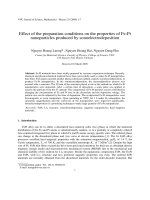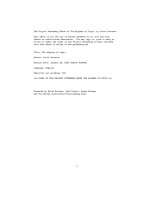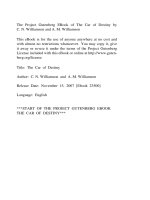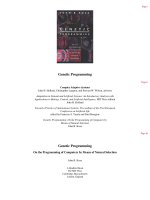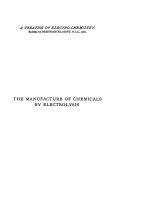the properties of solvents by yizhak marcus (wiley)
Bạn đang xem bản rút gọn của tài liệu. Xem và tải ngay bản đầy đủ của tài liệu tại đây (3.25 MB, 399 trang )
P
á
g
ina 1 de 1Document
11/10/2003htt
p
://emedia.netlibrar
y
.com/nlreader/nlreader.dll?bookid=17984&filename=cover.html
Page i
The Properties of Solvents
P
á
g
ina 1 de 1Document
11/10/2003htt
p
://emedia.netlibrar
y
.com/nlreader/nlreader.dll?bookid=17984&filename=Pa
g
e
_
i.html
Page ii
Wile
y
Series in Solution Chemistr
y
Editor-in-Chief
P. G. T. Fo
gg
,
Universit
y
o
f
North London, U
K
Editorial Board
W. E. Acree,
University of North Texas, USA
A. Bylicki,
Polish Academy of Sciences, Warsaw, Poland
A. F. Danil de Namor,
University of Surrey, UK
H. J. M. Grünbauer,
Dow Benelux NV, Ternauzen, The Netherlands
S. Krause,
Rensselaer Polytechnic Institute, Troy, USA
A. E. Mather,
University of Alberta, Canada
H. Ohtaki,
Ritsumeikan University, Kusatsu, Japan
A. D. Pelton,
Ecole Polytechnique de Montréal, Canada
M. Salomon,
US Army (ARL), Physical Sciences Directorate, Fort Monmouth, USA
A. Skrzecz,
Polish Academy of Sciences, Warsaw, Poland
R. P. T. Tomkins,
New Jersey Institute of Technology, USA
W. E. Waghorne,
University College, Dublin, Ireland
B. A. Wolf,
Johannes-Gutenberg-Universität, Mainz, Germany
C. L. Youn
g
,
Universit
y
o
f
Melbourne Australia
Volume 1
pH and Buffer Theory—A New Approach
H Rilbe
Chalmers Universit
y
o
f
Technolo
gy
, Gothenbur
g
, Sweden
Volume 2
Octanol-Water Partition Coefficients: Fundamentals and Physical Chemistry
J Sangster
San
g
ster Research Laboratories, Montreal, Canada
Volume 3
Crystallization Processes
Edited by
H Ohtaki
R
itsumeikan Universit
y
, Kusatsu, Japan
Volume 4
The Properties of Solvents
Y Marcus
The Hebrew Universit
y
o
f
Jerusalem, Israe
l
P
á
g
ina 1 de 1Document
11/10/2003htt
p
://emedia.netlibrar
y
.com/nlreader/nlreader.dll?bookid=17984&filename=Pa
g
e
_
ii.html
Page iii
The Properties of Solvents
Wiley Series in Solution Chemistry:
Volume 4
Y. Marcus
The Hebrew Universit
y
of Jerusalem, Israel
P
á
g
ina 1 de 1Document
11/10/2003htt
p
://emedia.netlibrar
y
.com/nlreader/nlreader.dll?bookid=17984&filename=Pa
g
e
_
iii.html
Page iv
Copyright © 1998 John Wiley & Sons Ltd,
Baffins Lane, Chichester,
West Sussex PO19 1UD, En
g
lan
d
N
ational 01243 779777
International (+44) 1243 779777
e-mail (for orders and customer service enquiries):
Visit our Home Page on
or htt
p
://www.wile
y
.com
Re
p
rinted October 1999
All Rights Reserved. No part of this publication may be reproduced, stored in a retrieval system, or
transmitted, in any form or by any means, electronic, mechanical, photocopying, recording, scanning or
otherwise, except under the terms of the Copyright, Designs and Patents Act, 1988 or under the terms o
f
a licence issued by the Copyright Licensing Agency, 90 Tottenham Court Road, London, UK W1P
9HE, without the
p
ermission in writin
g
of the Publisher.
Other Wile
y
Editorial O
ff
ices
John Wiley & Sons, Inc., 605 Third Avenue,
N
ew York, NY 10158-0012, USA
WILEY-VCH Verlag GmbH, Pappelallee 3,
D-69469 Weinheim, German
y
Jacaranda Wiley Ltd, 33 Park Road, Milton,
Queensland 4064, Australi
a
John Wiley & Son (Asia) Pte Ltd, 2 Clementi Loop #02–01,
Jin Xin
g
Distri
p
ark, Sin
g
a
p
ore 129809
John Wiley & Sons (Canada) Ltd, 22 Worcester Road,
Rexdale, Ontario M9W 1L1, Canada
L
ibrar
y
o
f
Con
g
ress Catalo
g
in
g
-in-
P
ublication Data
Marcus, Y.
The properties of solvents / Yitzhak Marcus.
p
. cm. - (Wiley series in solution chemistry ; v. 4)
Includes bibliographical references and index.
ISBN 0-471-98369-1 (alk. paper)
1. Solvents. 2. Solution (Chemistry) I. Title. II. Series.
Q544.M37 1999
541.3
′
482-dc21 98-18212
CIP
B
ritish Librar
y
Catalo
g
uin
g
in Publication Data
A catalo
g
ue record for this book is available from the British Librar
y
P
á
g
ina 1 de 2Document
11/10/2003htt
p
://emedia.netlibrar
y
.com/nlreader/nlreader.dll?bookid=17984&filename=Pa
g
e
_
iv.html
ISBN 0 471 98369 1
T
yp
eset in 10/12
p
t Times b
y
Ke
y
tec T
yp
esettin
g
Ltd, Brid
p
ort, Dorset
Printed and bound in Great Britain b
y
Biddles, Guildford, Surre
y
This book is printed on acid-free paper responsibly manufactured from sustainable forestry, in which at
least two trees are
p
lanted for each one used for
p
a
p
er
p
roduction.
P
á
g
ina 2 de 2Document
11/10/2003htt
p
://emedia.netlibrar
y
.com/nlreader/nlreader.dll?bookid=17984&filename=Pa
g
e
_
iv.html
Page v
Contents
Series Preface vii
Preface ix
List of S
y
mbols xi
Chapter 1
Introduction
1
1 A Surve
y
of Useful Solvents 1
2 Solvent Purit
y
and Purification Methods 13
3 Tests of Solvent Purit
y
15
4 Toxicit
y
and Other Hazards of Solvents 25
References 32
Chapter 2
Solvent Effects
34
1 Solvation 34
2 Solution Com
p
osition 36
3 Solvent Effects on Solubilit
y
and Partition 44
4 Solvent Effects on Chemical E
q
uilibria 50
5 Solvent Effects on Reaction Rates 55
6 Solvent Effects in S
p
ectrosco
py
58
7 Solvent Effects in Electrochemistr
y
62
References 65
P
á
g
ina 1 de 2Document
11/10/2003htt
p
://emedia.netlibrar
y
.com/nlreader/nlreader.dll?bookid=17984&filename=Pa
g
e
_
v.html
Chapter 3
Ph
y
sical Pro
p
erties of Solvents
67
1 The Li
q
uid Ran
g
e of Solvents 68
2 The
P
-V-
T
Pro
p
erties of Solvents 79
3 Va
p
orization Pro
p
erties of Solvents 81
4 The Heat Ca
p
acit
y
of Solvents 85
5 The Molecular Sizes of Solvents 85
6 Electrical and O
p
tical Pro
p
erties 94
7 Ma
g
netic Pro
p
erties of Solvents 109
8 Surface and Trans
p
ort Pro
p
erties 110
9 Water and Heav
y
Wate
r
125
References 127
P
á
g
ina 2 de 2Document
11/10/2003htt
p
://emedia.netlibrar
y
.com/nlreader/nlreader.dll?bookid=17984&filename=Pa
g
e
_
v.html
Page vi
Chapter 4
Chemical Pro
p
erties of Solvents
131
1 The Structuredness of Solvents 131
2 Solvent Polarit
y
142
3 Electron-Pair Donicit
y
154
4 H
y
dro
g
en Bondin
g
Abilit
y
160
5 Solvent Softness 163
6 Solvent Acidit
y
and Basicit
y
165
7 A
q
ueous Solubilit
y
and Partition 174
8 Windows for S
p
ectrosco
py
and Electrochemistr
y
187
References 199
Chapter 5
A
pp
lications
203
1 A Surve
y
of T
yp
ical A
pp
lications 203
2 A
pp
lications in Solvent Extraction 210
3 A
pp
lications in Electrochemistr
y
215
4 A
pp
lications in Or
g
anic Chemistr
y
218
5 A
pp
lications in Pol
y
mer Science and Technolo
gy
225
6 S
p
ecial Features of Water As Solvent 230
References 232
Index 235
P
á
g
ina 1 de 1Document
11/10/2003htt
p
://emedia.netlibrar
y
.com/nlreader/nlreader.dll?bookid=17984&filename=Pa
g
e
_
vi.html
Page vii
Series Preface
There are many aspects of solution chemistry. This is apparent from the wide range of topics which
have been discussed during recent International Conferences on Solution Chemistry and International
Symposia on Solubility Phenomena. The Wiley Series in Solution Chemistry was launched to fill the
need to present authoritative, comprehensive and upto-date accounts of these many aspects.
Internationally recognized experts from research or teaching institutions in various countries have been
invited to contribute to the Series.
Volumes in print or in preparation cover experimental investigation, theoretical interpretation and
p
rediction of physical chemical properties and behaviour of solutions. They also contain accounts of
industrial a
pp
lications and environmental conse
q
uences of
p
ro
p
erties of solutions.
Subject areas for the Series include: solutions of electrolytes, liquid mixtures, chemical equilibria in
solution, acid-base equilibria, vapour-liquid equilibria, liquid-liquid equilibria, solid-liquid equilibria,
equilibria in analytical chemistry, dissolution of gases in liquids, dissolution and precipitation,
solubility in cryogenic solvents, molten salt systems, solubility measurement techniques, solid
solutions, reactions within the solid phase, ion transport reactions away from the interface (i.e. in
homogeneous, bulk systems), liquid crystalline systems, solutions of macrocyclic compounds
(including macrocyclic electrolytes), polymer systems, molecular dynamic simulations, structural
chemistry of liquids and solutions, predictive techniques for properties of solutions, complex and multi-
component solutions applications, of solution chemistry to materials and metallurgy (oxide solutions,
alloys, mattes etc.), medical aspects of solubility, and environmental issues involving solution
p
henomena and homo
g
eneous com
p
onent
p
henomena.
Current and future volumes in the Series include both single-authored and multi-authored research
monographs and reference level works as well as edited collections of themed reviews and articles.
The
y
all contain com
p
rehensive biblio
g
ra
p
hies.
Volumes in the Series are important reading for chemists, physicists, chemical engineers and
technolo
g
ists as well as environmental scientists in academic and industrial institutions.
PETER FOGG
MAY 1996
P
á
g
ina 1 de 1Document
11/10/2003htt
p
://emedia.netlibrar
y
.com/nlreader/nlreader.dll?bookid=17984&filename=Pa
g
e
_
vii.html
Page x
endeavored in this book to present as many reliable data as seem to be relevant, without trying to be exhaustive, and
to provide these with appropriate annotations. . . . I hope that the long lists of references [following] the extensive
tables do not detract too much from the readability of the book. I preferred to have the tables right at the place
where the data are discussed or where they can be employed by the reader as an illustration to the points discussed,
rather than have them relegated to appendixes.'
Is it necessar
y
to
j
ustif
y
further the writin
g
of the
p
resent book?
The data collected and shown are from secondary sources—where they have previously been critically
evaluated and selected—whenever warranted, but more recent primary sources in research journals
have been used to supplement the former or to supersede them if deemed necessary. Access to the
p
rimary sources has been through the abstracts up to 1996. The selection of the solvents for which the
data are included in this book (the List) is discussed in the Introduction. I am solely responsible for such
choices, regarding solvents and data, as have been made. I will be grateful for indications of errors,
oversights, and further useful data that may be brought to my attention. Some of the tables are confined
to those solvents from the List for which the relevant data have been reported. However, for most of the
more extensive tables, many blank spaces have been left, and in some cases entire rows of data have
been left blank. This was done with the hope of calling attention to the lack of reliable data, and the
expectation that some of these blanks may be filled within the useful lifetime of this book (and its
author
)
.
Y. MARCUS
JERUSALEM,
JUNE 1998
P
á
g
ina 1 de 1Document
11/10/2003htt
p
://emedia.netlibrar
y
.com/nlreader/nlreader.dll?bookid=17984&filename=Pa
g
e
_
x.html
Page xi
List of S
y
mbols
A
surface area of a molecule
A
vdW
van der Waals surface area
A, B, C
constants in the Antoine equation
AN
(Gutmann–Mayer) acceptor number
a
activity
a
diameter of ion (distance of closest approach)
a, b
constants in the van der Walls equation
B
(Koppel–Palm) donicity scale
B
second virial coefficient
b
ε
non-linear dielectric effect
C
p
constant pressure molar heat capacity
C
V
constant volume molar heat capacity
c
(volume) concentration (moles per dm
-3
of solution)
c
specific heat (constant pressure)
c
speed of light, 2.997 92 × 10
8
ms
-1
cmc
critical micelle concentration
D debye unit of dipole moment, 3.335 64 × 10
-3
C.m
D
(self) diffusion coefficient
DN
(Gutmann) donor number
D
S
(Persson) softness parameter
d
density
d
C
critical density
E
electric field strength
E
o
standard electrode potential
E
1/2
polarographic half-wave potential
E
conf
configurational energy
normalized (Dimroth–Reichardt) polarity index
E
T
(30) (Dimroth–Reichardt) polarity index
∆
E
η
activation energy for viscous flow
F
Faraday's constant, 96 485 C mol
-1
P
á
g
ina 1 de 2Document
11/10/2003htt
p
://emedia.netlibrar
y
.com/nlreader/nlreader.dll?bookid=17984&filename=Pa
g
e
_
xi.html
ƒ
fugacity
P
á
g
ina 2 de 2Document
11/10/2003htt
p
://emedia.netlibrar
y
.com/nlreader/nlreader.dll?bookid=17984&filename=Pa
g
e
_
xi.html
Page xiii
R
gas constant, 8.3145 J K
-1
mol
-1
R
D
molar refractivity at the sodium D-line
r
radius
r
distance from center of particle
∆S
*
solvation entropy
∆
S
o
standard entropy change
∆
S
≠
entropy of activation
∆
S
F
(molar) entropy of fusion
S
N
1 monomolecular nucleophilic substitution reaction
S
N
2 bimolecular nucleophilic substitution reaction
s
molar solubility
T
absolute tmeperature
T
0
ideal glass transition temperature
T
b
(normal, absolute) temperature of boiling
T
C
critical temperature
T
g
(absolute) glass transition temperature
T
m
(absolute) temperature of melting
T
r
reduced temperature,
T / T
C
T
t
triple point
t
b
(normal) boiling point (in °C)
t
m
melting temperature (in °C)
∆
V
U
vaporization energy
u
ion mobility
u(r)
pair potential
u
LJ
(r)
Lennard–Jones pair potential
∆
V
*
solvation volume
∆
V
o
standard volume change
∆
V
≠
volume of activation
V
E
(excess) molar volume of mixing
V
L
(Leahy) intrinsic volume
V
vdW
van der Waals volume
V
X
(McGowan) intrinsic volume
P
á
g
ina 1 de 2Document
11/10/2003htt
p
://emedia.netlibrar
y
.com/nlreader/nlreader.dll?bookid=17984&filename=Pa
g
e
_
xiii.html
w
mass (weight) fraction
XYZ
generalized solvent-dependent variable
x
mole fraction
Y
(Grunwald–Winstein) solvent polarity parameter
y
packing fraction
Z
(Kosower) polarity index
Z
C
critical compressibility factor
z
(algebraic) charge of ion
[ ] concentration of the enclosed species
α
polarizability
P
á
g
ina 2 de 2Document
11/10/2003htt
p
://emedia.netlibrar
y
.com/nlreader/nlreader.dll?bookid=17984&filename=Pa
g
e
_
xiii.html
Page xiv
α
number of solvent molecules sorbed per phenyl group in
polystyrene
α
(Kamlet–Taft) hydrogen bond donation ability
α
ultrasound absorption coefficient
α
P
isobaric expansibility
β
(Kamlet–Taft) electron pair donation ability
γ
Ostwald coefficient (for gas solubility)
γ
±
mean ionic activity coefficient
w
γ
s
transfer activity coefficient from solvent w to solvent s
δ
(Hildebrand) solubility parameter
δ
NMR chemical shift
δ
(Kamlet–Taft) polarizability parameter
ε
(negative of the) depth of the potential well
ε
relative permittivity (dielectric constant)
ε
o
permittivity of free space, 8.8542 × 10
-12
C
2
J
-1
m
-1
ε
0
static, low frequency, relative permittivity
ε
∞
relative permittivity at very high ('infinite') frequency
η
(dynamic) viscosity
κ
specific conductance
κ
S
isentropic, adiabatic compressibility
κ
T
isothermal compressibility
λ
equivalent conductivity
λ
thermal conductivity, W K
-1
m
-1
λ
c
critical wavelength
µ
dipole moment
µ
(Marcus) softness parameter
ν
wavenumber
ξ
correlation length
π
group contribution to the 1-octanol/water partition constant
π
*
(Kamlet–Taft) polarity/polarizability parameter
ρ
number density
P
á
g
ina 1 de 2Document
11/10/2003htt
p
://emedia.netlibrar
y
.com/nlreader/nlreader.dll?bookid=17984&filename=Pa
g
e
_
xiv.html
σ
surface tension
σ
collision diameter of molecules
τ
(orientational) relaxation time
Φ
fluidity
φ
volume fraction in actual mixture
ϕ
volume fraction when volume change on mixing is
disregarded
χ
molar volume diamagnetic susceptibility
χ
(Flory–Huggins) interaction parameter
ω
electric field frequency
P
á
g
ina 2 de 2Document
11/10/2003htt
p
://emedia.netlibrar
y
.com/nlreader/nlreader.dll?bookid=17984&filename=Pa
g
e
_
xiv.html
Page 1
Chapter 1—
Introduction
1—
A Surve
y
of Useful Solvents
Solvents are substances that are liquid under the conditions of application and in which other substances
can dissolve, and from which they can be recovered unchanged on removal of the solvent. So many
substances conform to this definition—practically all those that can be liquefied under some
conditions—that it is not very helpful, unless the word 'application' is stressed, meaning that the
solvents and the solutions in them ought to be applicable for some purpose. In the present context,
therefore, materials that can be liquefied only under extreme conditions of temperature and presfsure
will not be considered extensively. This excludes, for instance, molten salts and slags on the one hand
and 'permanent' gases on the other, unless they have found some use as 'supercritical solvents'. Then,
again, binary or multi-component liquid mixtures are not dealt with here, although they can be very
useful as solvents, since this would have expanded the size of this book enormously. This still leaves a
host of organic and many inorganic substances that are liquid at or near ambient conditions, which
could be considered to be solvents under the present definition. Of these, a limited number are selected,
in order for this book to be useful and handy, rather than trying in vain to be comprehensive and
enc
y
clo
p
edic.
The solvents that are included in the extensive compilations of physical and chemical properties shown
in this book (the List, referred to as such in this book) have been selected so as to cover the major
classes of solvents, and bring several examples of each class. The properties of solvents that have not
been included, but that belong to these classes, in particular isomers or higher members of homologous
series, can often be inferred from the reported data at least to some extent. One criterion according to
which solvents have been selected for inclusion in the List is that most of their physical and chemical
p
roperties, among those considered here, should be known. In particular, those chemical properties
p
ertaining to their ability to solvate solutes are stressed as criteria for inclusion, since this book is a part
of a series on Solution Chemistr
y
. This solvatin
g
abilit
y
P
á
g
ina 1 de 1Document
11/10/2003htt
p
://emedia.netlibrar
y
.com/nlreader/nlreader.dll?bookid=17984&filename=Pa
g
e
_
1.html
Page 2
can be characterized by so-called solvatochromic parameters or similar indices of solvation ability, and
some, at least, of the most commonly used of these parameters, ought to be known for inclusion of the
solvent in the List.
Water, being the most abundant, extensively employed, and a very useful solvent, has always been
accorded very wide attention by chemists of all subdisciplines who have been studying solutions. As an
antithesis, the keyword 'non-aqueous' has figured in the titles of many treatments of other solvents.
Inorganic solvents have long been considered to be the typical 'non-aqueous solvents', as is manifested
in the titles of several books dealing almost exclusively with them, written or edited in the fifties and
early sixties by authors such as (Audrieth and Kleinberg 1953; Sisler 1961; Waddington 1965). Only
little attention was accorded at the time to organic non-aqueous solvents. In the last few decades,
however, this tendency has reversed completely, and a large number of organic, in particular dipolar
aprotic, solvents have been dealt with extensively in this context of 'non-aqueous solvents', almost to
the exclusion of the traditional inorganic ones, as, for instance, in the books edited by (Coetzee and
Ritchie 1969; Lagowski 1966–1978; Covington and Jones 1968). However, the older compilations of
p
hysical properties of organic substances (International Critical Tables 1926–1930; Landold–Börnstein
Tables 1959 and Timmermann's compilation) do not include most of the now commonly used dipolar
aprotic solvents, the relevant data being found only in more recent works, e.g., (Riddick, Bunger and
Sakano 1986 and the DIPPR compilation 1997). Then, again, in many books with extensive data,
solvents used for electrolytes or ions, polar solvents, whether protic or not, are not always considered
together with those used for non-polar commercial materials, such as paints, polymers, etc., or for
p
harmaceuticals and industrial
p
rocesses. Here, both kinds are accorded the a
pp
ro
p
riate s
p
ace.
A classification scheme for solvents needs, therefore, to reflect to some extent the uses for which the
solvents are put. Many classification schemes have been proposed, and a single major property, that
may form the basis for the usefulness of solvents for certain applications, can often be employed in
order to classify solvents. On the other hand, a few selected properties may advantageously be used to
form the basis for the classification. Various solvent classification schemes have been presented
(
Reichardt 1988
)
and a common solvent classification scheme is:
(i) non-polar solvents (such as hexane and tetrachloromethane),
(ii) solvents of low polarity (such as toluene and chloroform),
(iii) aprotic dipolar solvents (such as acetone and N,N-dimethylformamide),
(iv) protic and protogenic solvents (such as ethanol and nitromethane),
(v) basic solvents (such as pyridine and 1,2-diaminoethane), and
(
vi
)
acidic solvents
(
such as 3-meth
y
l
p
henol and butanoic acid
)
.
Some other classification schemes shown below (that differ from the one above only in minor details or
in the terminology) are as follows. One classification, (Kolthoff 1974) and (Reichardt 1988), called
A
b
elow, is accordin
g
to the
P
á
g
ina 1 de 1Document
11/10/2003htt
p
://emedia.netlibrar
y
.com/nlreader/nlreader.dll?bookid=17984&filename=Pa
g
e
_
2.html
Page 3
p
olarity, described by the relative permittivity (dielectric constant)
ε
the dipole moment
µ
(in 10
-30
C.m), and the hydrogen bond donation ability (see Chapter 4). Another suggested classification
(Parker), called
B
below, stresses the acidity and basicity (relative to water) of the solvents. A third one,
(Chastrette 1974, 1979), called
C
below, stresses the hydrogen bonding and electron pair donation
abilities, the polarity, and the extent of self-association. As stated above, the differences among these
schemes are mainl
y
semantic ones and are of no real conse
q
uence.
Solvent classification scheme
A
.
Designation
εµ
Examples
apolar aprotic < 15 < 8.3 0.0–0.3
hydrocarbons, halogen substituted
hydrocarbons, tertiary amines
weakly polar aprotic < 15 < 8.3
ethers, esters, pyridine, primary and
secondary amines
dipolar aprotic > 15 > 8.3 0.3–0.5
ketones, nitriles, nitro-compounds,
N
,N-disubstituted amides, sulfoxides
protic
0.5–1.0
water, alcohols, mono- or
unsubstituted amides, carboxylic
acids, ammonia
Solvent classification scheme
B
.
Solvent designation Relative acidity/basicity Examples
protic–neutral fairly strong as either
H
2
O, CH
3
OH, (CH
3
)
3
COH, C
6
H
5
OH
protogenic more acid than water
H
2
SO
4
, HCOOH
protophilic more basic than water
NH
3
, HCONH
2
, H
2
NC
2
H
4
NH
2
aprotic, protophilic more basic and less acidic than
water
HCON(CH
3
)
2
, CH
3
SOCH
3
, C
5
H
5
N, (C
2
H
5
)
2
O, tetrahydrofuran
aprotic, protophobic fairly weak as either
CH
3
CN, CH
3
COCH
3
, CH
3
NO
2
aprotic, inert fairly weak as either
C
6
H
14
, C
6
H
6
, ClC
2
H
4
Cl, CCl
4
Solvent classification scheme
C
.
Solvent class Examples
apolar, aprotic, electron pair donors amines, ethers
slightly polar, aprotic, aromatic chlorobenzene, anisole, acetophenone
apolar, aprotic, aromatic benzene, substituted aromatic hydrocarbons
aprotic dipolar nitromethane, acetonitrile, acetone, pyridine
highly polar aprotic dimethyl sulfoxide, bezonitrile, nitrobenzene
highly polar, polarizable aprotic sulfolane, hexamethyl phosphoramide
hydrogen bonding alcohols, ether-alcohols, phenols
P
á
g
ina 1 de 2Document
11/10/2003htt
p
://emedia.netlibrar
y
.com/nlreader/nlreader.dll?bookid=17984&filename=Pa
g
e
_
3.html
highly associated hydrogen bonding water, ethylene glycol, formamide
miscellaneous choloroform, carbon disulfide, aniline
P
á
g
ina 2 de 2Document
11/10/2003htt
p
://emedia.netlibrar
y
.com/nlreader/nlreader.dll?bookid=17984&filename=Pa
g
e
_
3.html
Page 4
In the following, the chemical constitution scheme (Riddick, Bunger and Sakano 1986) is followed,
with some minor alterations in their sequence. This sequence is followed in the Tables that constitute
the major part of this book and is: aliphatic hydrocarbons, aromatic hydrocarbons, alcohols, phenols,
ethers, aldehydes, ketones, carboxylic acids, esters, halogen-substituted hydrocarbons, amines, nitriles
and nitro-derivatives, amides, sulfur-containing solvents, phosphorus-containing solvents, and inorganic
solvents. Alicyclic solvents are included with the straight-chain ones, and aliphatic solvents precede
aromatic and heterocyclic ones. Bifunctional solvents are included with those to which the arbitrarily
deemed more important function belongs .Water is considered to be the smallest alkanol, but ammonia,
rather than as the shortest amine, is included with the inor
g
anic solvents.
Table 1.1 shows the solvents on the List, that are dealt with in the following sections of the book. An
ordinal number in the first column identifies the solvents and can be used for their consistent
sequencing. Several alternative names can be assigned to each solvent, and a commonly used one is
employed here, without prejudice to other commonly employed ones. Neither is the nomenclature used
trying to drive the systematic (IUPAC) nomenclature to its most absurd length. The abbreviations c
≡
cyclo, n
≡
normal, i
≡
iso, and t
≡
tertiary, as well as o
≡
ortho, m
≡
meta, and p
≡
para are used in the
names.
Since many solvents have quite common synonyms that are in widespread use, such synonyms are also
listed in Table 1.1. Not all common synonyms are shown, and in several cases some permutations of the
elements of the name or the Chemical Abstracts name are used as synonyms. In a few cases, Tables and
text in other sections of the book refer to these synonyms rather than to the names in the second
column, but the serial number shown should
p
revent an
y
errors of identification.
In order to specify the solvent more clearly, its linear structural formula is given in the fourth column,
where in order to save space the common abbreviations Me
≡
methyl and Ph
≡
phenyl are used and c-
. . .
- denotes a cyclic compound. (Bicyclic solvents, such as quinoline, could not be illustrated by this
device.) The compositional formula in the fifth column follows the convention of alphabetical listing of
the atoms in the molecule of the solvent, but with 'C' for carbon being followed first by 'H' for
hydrogen, before other kinds of atoms in organic molecules. The entries in this column help in locating
the solvent in formula indexes and listin
g
s made accordin
g
to the com
p
ositional formula.
A further aid in the location of the solvents and their exact specification is the Chemical Abstracts
name, shown in the sixth column of Table 1.1, and the Chemical Abstracts (CAS) Registry Number,
shown in the seventh. The Chemical Abstracts name may be the same as the commonly used one or
may differ from it considerably, so that it is not always easy to find the solvents in the Chemical
Substance Indexes of the Chemical Abstracts. For instance, 'benzene, methyl' is a fairly transparent
name for toluene, and 'methanol,
p
hen
y
l' a sli
g
htl
y
P
á
g
ina 1 de 1Document
11/10/2003htt
p
://emedia.netlibrar
y
.com/nlreader/nlreader.dll?bookid=17984&filename=Pa
g
e
_
4.html
Page 5
Table 1.1
Nominal data of the solvents on the Lis
t
No. Name Synonym Structural Formula Composition Chem. Abstr. Name Cas. Reg. No
10 tetramethylsilane
Me
4
Si C
4
H
12
Si
silane, tetramethyl 75-76-3
20 n-pentane
CH
3
(CH
2
)
3
CH
3
C
5
H
12
pentane 109-66-0
30 2-methylbutane isopentane
Me
2
CHCH
2
CH
3
C
5
H
12
butane, 2-methyl 78-78-4
40 n-hexane
CH
3
(CH
2
)
4
CH
3
C
6
H
14
hexane 110-54-3
50 c-hexane
c-(CH
2
)
6
-C
6
H
12
cyclohexane 110-82-7
60 n-heptane
CH
3
(CH
2
)
5
CH
3
C
7
H
16
heptane 142-82-5
70 n-octane
CH
3
(CH
2
)
6
CH
3
C
8
H
18
octane 111-65-9
80 2,2,4-trimethylpentane isooctane
CH
3
CMe
2
CH
2
CHMe
2
C
8
H
18
pentane, 2,2,4-trimethyl 540-84-1
90 n-decane
CH
3
(CH
2
)
8
CH
3
C
10
H
22
decane 124-18-5
100 n-dodecane
CH
3
(CH
2
)
10
CH
3
C
12
H
26
dodecane 112-40-3
110 n-hexadecane cetane
CH
3
(CH
2
)
14
CH
3
C
16
H
34
hexadecane 544-76-3
120 benzene
C
6
H
6
C
6
H
6
benzene 71-43-2
130 toluene
PhMe
C
7
H
8
benzene, methyl 108-88-3
140 o-xylene
1,2-PhMe
2
C
8
H
10
benzene, 1,2-dimethyl 95-47-6
150 m-xylene
1,3-PhMe
2
C
8
H
10
benzene, 1,3-dimethyl 108-38-3
160 p-xylene
1,4-PhMe
2
C
8
H
10
benzene, 1,4-dimethyl 106-42-3
170 ethylbenzene
PhC
2
H
5
C
8
H
10
benzene, ethyl 100-41-4
180 isopropylbenzene cumene
PhCHMe
2
C
9
H
12
benzene, 1-methylethyl 98-82-8
190 mesitylene
1,3,5-C
6
H
3
Me
3
C
9
H
12
benzene, 1,3,5-trimethyl 108-67-8
200 styrene vinylbenzene
PhCH=CH
2
C
8
H
8
benzene, ethenyl 100-42-5
210 tetralin tetrahydronaphthalen
1,2-Ph-c-(CH
2
)
4
-C
10
H
12
naphthalene, tetrahydro 119-64-2
P
á
g
ina 1 de 2
11/10/2003file://E:\DOCUME~1\andresfe\CONFIG~1\Tem
p
\Y9AJGP7Y.htm
220 cis-decalin decahydronaphthalen
C
10
H
16
naphthalene, decahydro 493-01-6
230 water
HOH
H
2
O
water 7732-18-5
240 methanol methyl alcohol MeOH
CH
4
O
methanol 67-56-1
250 ethanol ethyl alcohol
C
2
H
5
OH C
2
H
6
O
ethanol 64-17-5
260 1-propanol n-propyl alcohol
C
3
H
7
OH C
3
H
8
O
1-propanol 71-23-8
270 2-propanol isopropyl alcohol
Me
2
CHOH C
3
H
8
O
2-propanol 67-63-0
280 1-butanol n-butyl alcohol
C
4
H
9
OH C
4
H
10
O
1-butanol 71-36-3
290 2-methyl-1-propanol isobutyl alcohol
Me
2
CHCH
2
OH C
4
H
10
O
1-propanol, 2-methyl 78-83-1
300 2-butanol s-butyl alcohol
C
2
H
5
CH(OH)CH
3
C
4
H
10
O
2-butanol 78-92-2
310 2-methyl-2-propanol t-butyl alcohol
Me
3
COH C
4
H
10
O
2-propanol, 2-methyl 76-65-0
320 n-pentanol n-pentyl alcohol
C
5
H
11
OH C
5
H
12
O
1-pentanol 71-41-0
continued overlea
f
P
á
g
ina 2 de 2
11/10/2003file://E:\DOCUME~1\andresfe\CONFIG~1\Tem
p
\Y9AJGP7Y.htm
Page 6
Table 1.1
(
continued
)
No. Name Synonym Structural Formula Composition Chem.Abstr. Name Cas. Reg. No
330 i-pentanol amyl alcohol
Me
2
CHCH
2
CH
2
OH C
5
H
12
O
1-butanol, 3-methyl 123-51-3
340 t-pentanol t-pentyl alcohol
CH
3
CH
2
CMe
2
OH C
5
H
12
O
2-butanol, 2-methyl 75-85-4
350 n-hexanol n-hexyl alcohol
C
6
H
13
OH C
6
H
14
O
1-hexanol 111-27-3
360 c-hexanol cyclohexyl alcohol
c-C
6
H
11
OH C
6
H
12
O
cyclohexanol 108-93-0
370 n-octanol n-octyl alcohol
C
8
H
17
OH C
8
H
18
O
1-octanol 111-87-5
380 n-decanol n-decyl alcohol
C
10
H
21
OH C
10
H
22
O
1-decanol 112-30-1
390 n-dodecanol lauryl alcohol
C
12
H
25
OH C
12
H
26
O
1-dodecanol 112-53-8
400 benzyl alcohol
PhCH
2
OH C
7
H
8
O
benzenemethanol 100-51-6
410 2-phenylethanol
PhCH
2
CH
2
OH C
8
H
10
O
ethanol, 2-phenyl 1321-27-3
420 allyl alcohol
CH
2
=CHCH
2
OH C
3
H
6
O
2-propen-1-ol 107-18-6
430 2-chloroethanol glycol chlorhydrine
ClCH
2
CH
2
OH C
2
H
5
ClO
ethanol, 2-chloro 107-07-3
440 2-cyanoethanol
NCCH
2
CH
2
OH C
3
H
5
NO
propanenitrile, 3-hydroxy 109-78-4
450 2,2,2-trifluoroethanol
F
3
CCH
2
OH C
2
H
3
F
3
O
ethanol, 2,2,2-trifluoro- 75-89-8
460 hexafluoro-i-propanol
CF
3
CH(OH)CF
3
C
3
H
2
F
6
O
2-propanol, 1,1,1,3,3,3-
hexafluoro-
920-66-1
470 2-methoxyethanol methyl cellosolve
MeOCH
2
CH
2
OH C
3
H
8
O
ethanol, 2-methoxy 109-86-4
480 2-ethoxyethanol cellosolve
C
2
H
5
OCH
2
CH
2
OH C
4
H
10
O
ethanol, 2-ethoxy 110-80-5
490 1,2-ethanediol ethylene glycol
HOCH
2
CH
2
OH C
2
H
6
O
2
1,2-ethanediol 107-21-1
500 1,2-propanediol 1,2-propylene glycol
HOCH
2
CH(OH)CH
3
C
3
H
8
O
2
1,2-propanediol 57-55-6
510 1,3-propanediol 1,3-propylene glycol
HOCH
2
CH
2
CH
2
OH C
3
H
8
O
2
1,3-propanediol 504-63-2
520 1,2-butanediol 1,2-butylene glycol
HOCH
2
CH(OH)CH
2
CH
3
C
4
H
10
O
2
1,2-butanediol 584-03-2
P
á
g
ina 1 de 2Document
11/10/2003htt
p
://emedia.netlibrar
y
.com/nlreader/nlreader.dll?bookid=17984&filename=Pa
g
e
_
6.html
